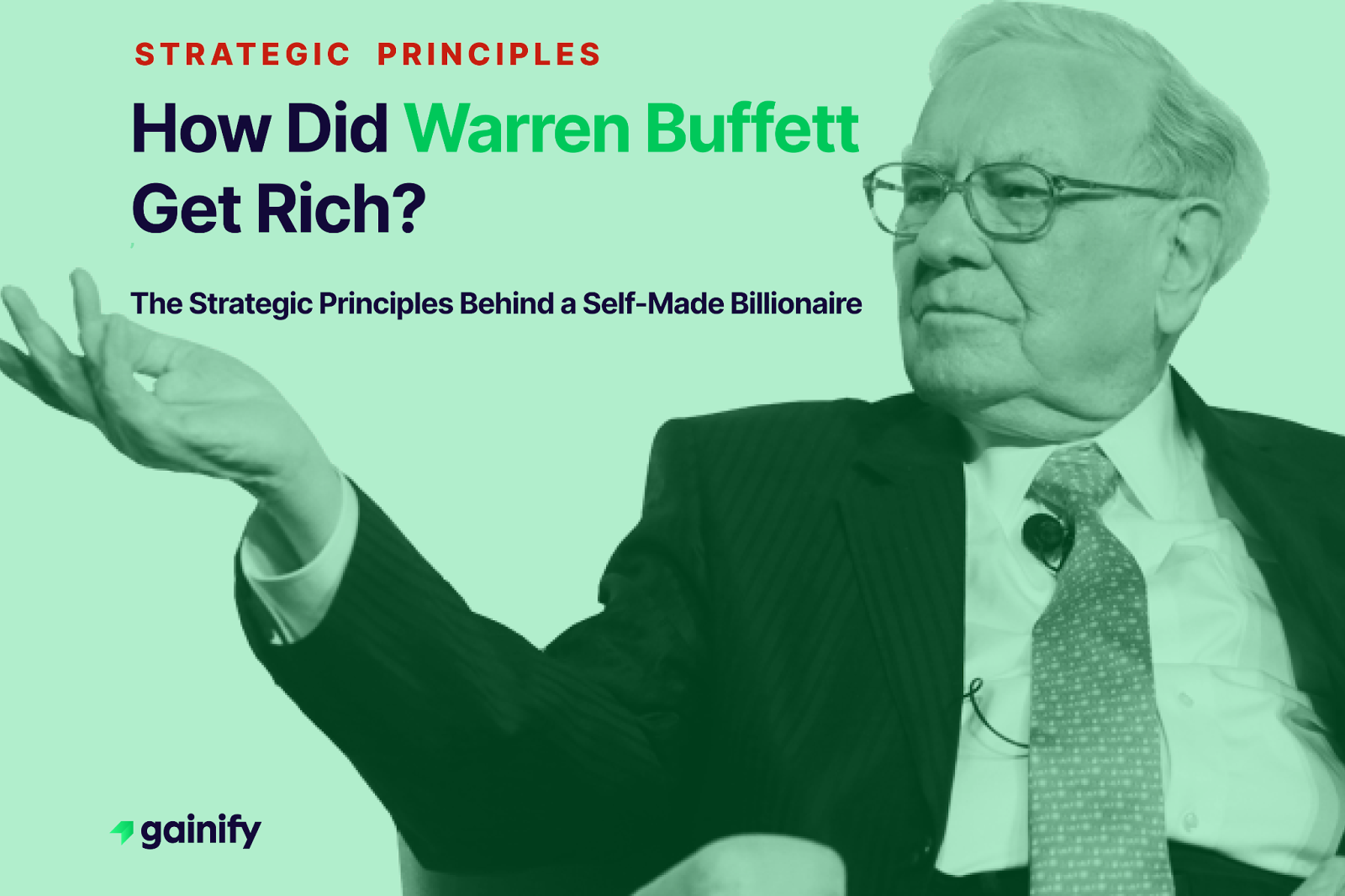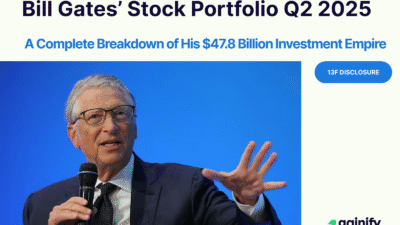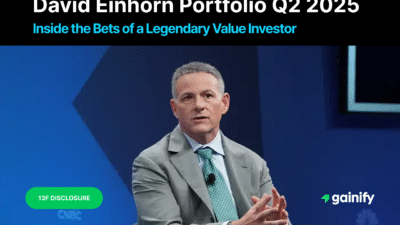When people hear the name Warren Buffett, they often think of billions in net worth and legendary quotes about patience, discipline, and long-term investing. He’s known worldwide as the “Oracle of Omaha,” but his wealth wasn’t built on luck or inheritance. It was built through a deep understanding of how money compounds, and how to stay consistent while others chase shortcuts.
So how did Warren Buffett actually become one of the richest investors in history?
The honest answer is that he mastered the art of capital allocation and stuck to a value investing strategy that many investors find too slow or boring to follow. But that boring strategy has outperformed nearly every other.
Buffett’s approach centers on buying businesses he understands, managing risk carefully, and using tax-efficient structures to preserve gains. He focuses on fundamentals like cash flow, earnings quality, and long-term durability rather than chasing hype or market momentum.
This article breaks down the exact playbook Warren Buffett used to build his fortune. From his early ventures and partnership with Charlie Munger to the structure of Berkshire Hathaway, we’ll explore the investment principles that continue to shape smart investors today. Whether you’re new to investing or refining your strategy, there’s something to learn from how Buffett built wealth with clarity, patience, and purpose.
1. He Started Early and Understood Compounding
Warren Buffett began investing long before most people know what a stock is. At just 11 years old, he purchased his first shares of Cities Service Preferred. By his teenage years, he was running small businesses, including a pinball machine operation placed inside local barbershops. These early ventures weren’t just for fun. They laid the foundation for his understanding of money, ownership, and business strategy.
Buffett often attributes a large part of his success to starting early. The longer your money is invested, the more it can benefit from compounding. Compounding is simple in concept but powerful in effect. It rewards consistency and patience, two qualities Buffett developed from a young age. As he once joked, his secret was “starting early, living in America, and having good genes.”
But it wasn’t just about numbers. In his early twenties, Buffett enrolled in a Dale Carnegie public speaking course. He has said many times that this was one of the most valuable decisions of his life. Learning to communicate clearly helped him build trust, explain ideas, and lead with confidence – all essential to his long-term success.
What truly sets Buffett apart is his long view. He didn’t just invest money early. He invested in knowledge, communication, and habits that compounded over time. His story is a reminder that wealth isn’t just about picking the right stocks. It’s about starting early, staying focused, and letting time do the heavy lifting.
2. He Followed Value Investing Principles
Buffett built his investment philosophy on the principles of value investing. This approach was shaped by his time studying under Benjamin Graham at Columbia Business School. Graham, widely considered the father of value investing, taught Buffett to focus on buying stocks that were trading below their intrinsic value. This meant looking for companies that were fundamentally strong but temporarily undervalued by the market.
Buffett also learned to prioritize companies with low debt, strong earnings, and a track record of steadily growing performance. He understood that investing in financially sound businesses reduced risk and allowed for compounding over time. His early study of Graham’s book The Intelligent Investor gave him a lifelong framework for making disciplined and rational choices.
Rather than chasing market trends, Buffett emphasized buying with a margin of safety. He applied this by:
- Purchasing businesses at a discount to their true worth
- Focusing on public companies with steadily growing, reliable earnings
- Backing leadership teams with integrity and competence
- Favoring companies with a durable competitive advantage, often called an “economic moat”
Buffett’s strategy made it easier to avoid speculation. He didn’t try to time the market or predict short-term moves. Instead, he built wealth through long-term, research-driven investing in businesses he understood. This approach allowed him to stay calm during market turbulence and hold quality investments for decades.
His disciplined focus on fundamentals over hype continues to influence thousands of investors today, proving that clear principles often outperform clever predictions.
3. He Built Wealth Through Investment Partnerships
Warren Buffett started building real wealth by managing investment partnerships. In the mid-1950s, after returning to Omaha, he founded Buffett Partnerships Ltd. These small investment partnerships were funded by people close to him, including friends, family, and local business leaders who believed in his ability.
Buffett structured the partnerships with a focus on fairness. He charged no management fee, taking only a portion of the profits if returns exceeded a set benchmark. This model aligned his incentives with those of his partners and set a high ethical standard that stood out in the investment world.
Through disciplined stock selection and deep research, Buffett achieved returns that consistently beat the market. His ability to find undervalued companies and hold them with patience laid the foundation for long-term success. These early gains eventually gave him the capital to acquire a struggling textile company, which he would later turn into Berkshire Hathaway.
This period also marked the beginning of his now-famous shareholder letters. He used them to explain his decisions, share his investment philosophy, and keep his partners informed. These letters became a masterclass in business thinking and are still studied by investors and MBA students around the world.
Buffett’s early strategy shows how results, transparency, and long-term thinking can create trust, scale wealth, and lay the foundation for one of history’s most successful investment firms.
4. He Transformed a Textile Business Into a Global Powerhouse
Buffett turned a declining textile company into one of the most successful conglomerates in history. His journey with Berkshire Hathaway began in the early 1960s when he started buying shares because he believed the stock was undervalued. After disagreements with the existing management, he eventually took control of the company.
Although the textile business continued to weaken, Buffett saw Berkshire as more than a mill operation. He used it as a holding company to acquire better businesses, ones with consistent earnings, strong leadership, and long-term value.
One of his most impactful decisions was acquiring insurance companies. These firms collected premiums, which is the money collected from premiums before any claims are paid. Buffett invested this capital in high-return opportunities, giving him access to long-term funding without relying heavily on debt or external financing.
Over time, Berkshire Hathaway acquired entire businesses like GEICO, BNSF Railway, and Dairy Queen. It also took significant positions in companies such as Coca-Cola, American Express, and Kraft Heinz. Each investment reflected Buffett’s philosophy of buying high-quality companies at a fair price and holding them for the long run.
This transformation from a struggling industrial company to a diversified global powerhouse stands as a case study in disciplined capital allocation and long-term thinking.
5. He Partnered with Charlie Munger to Refine His Strategy
Buffett’s investment approach matured significantly after teaming up with Charlie Munger. Munger, a lawyer and investor with a sharp philosophical lens, challenged Buffett to think beyond just buying cheap stocks. He urged him to look for high-quality businesses that could grow and compound over time.
This influence led Buffett to evolve from a deep-value, bargain-seeking investor into someone who prioritized long-term competitive advantages and strong fundamentals. Rather than focusing only on price, he began evaluating the true worth of a business and the quality of its management.
Together, Buffett and Munger emphasized owning great companies with durable economic moats and predictable cash flows. Their strategy focused on sustainable earnings, high returns on capital, and smart capital allocation.
For decades, the two shared the stage at Berkshire’s iconic annual meetings, offering unmatched insight into business and investing. Following Munger’s passing in 2024 and Buffett’s final shareholder meeting in 2025, their partnership has taken on a historic weight. It marked the close of an era defined not by speculation, but by principle, wisdom, and discipline.
Buffett has often said that Munger made him a better investor, not just by improving returns, but by improving decision-making. That evolution remains one of the most defining aspects of his legacy.
6. He Used Insurance Float to Multiply Capital Efficiently
One of Buffett’s most powerful advantages has been his use of insurance float to fund investments. When Berkshire Hathaway acquired insurance companies like GEICO and National Indemnity, it gained access to capital in the form of premiums paid by policyholders. This money, known as “float,” could be invested while claims were still years away from being paid.
Float operates like an interest-free loan, giving Buffett a steady stream of capital without relying on traditional debt or outside investors. Unlike borrowed funds, float comes with no repayment obligation if managed well. This allowed Buffett to expand aggressively without diluting ownership or taking on costly liabilities.
Buffett invested this float into high-quality businesses and long-term stock holdings. Instead of chasing trends, he focused on companies with durable advantages, strong leadership, and proven earnings power. With float compounding alongside Berkshire’s other profits, the company’s financial engine grew stronger each year.
This strategy also gave Berkshire Hathaway remarkable flexibility. During times of market stress, when others were forced to sell, Buffett had liquidity and confidence. His ability to buy when others were fearful has become a hallmark of his investment success.
Today, Berkshire’s float exceeds $160 billion. It remains one of the clearest examples of how Buffett blended operational business models with sound financial engineering to build long-term wealth.
7. From Business Ventures to Billionaire
Warren Buffett became a billionaire not through a lucky break but through decades of disciplined investing and careful capital allocation. His wealth was built steadily, deal by deal, decision by decision, with an unwavering commitment to fundamentals.
Buffett avoided market fads and speculative manias. Instead, he focused on businesses with strong cash flow, consistent returns on equity, healthy profit margins, and competent leadership. He understood that long-term success in investing comes from owning great businesses and letting time do the compounding.
His personal life reflected the same mindset. He has lived in the same Omaha home since 1958 and famously avoids extravagance. This minimalist lifestyle allowed him to reinvest more of his capital, maintain focus, and sidestep the distractions that often accompany wealth.
At Berkshire Hathaway, Buffett insisted on simplicity and transparency. His annual letters to shareholders are considered must-reads for investors because they explain complex ideas with clarity and logic. He built trust by speaking directly, writing clearly, and treating shareholders like partners.
Buffett’s rise from running small businesses as a teenager to leading one of the world’s most admired holding companies proves that wealth built on patience, principles, and precision is not only possible – it is sustainable.
8. Buffett’s Legacy and Why It Still Matters
Warren Buffett’s impact goes well beyond the billions he amassed. His legacy is defined by a disciplined approach to investing, a commitment to ethical leadership, and an ability to articulate timeless financial principles in a way that resonates with professionals and retail investors alike.
He redefined what it means to be a great investor. Rather than chasing short-term trends or speculative gains, Buffett championed clarity, consistency, and long-term value. His success proved that financial markets reward patience, sound judgment, and rational thinking.
His insights have been studied, published, and shared around the world. Seminal works like The Warren Buffett Way, along with widely circulated shareholder letters archived by platforms like the Wayback Machine, have become foundational texts in the investing world.
Buffett’s influence also extends into corporate governance and education. His views on stewardship, executive responsibility, and shareholder communication have shaped how boards, fund managers, and business schools evaluate performance and leadership. His emphasis on intrinsic value, capital efficiency, and transparent reporting continues to serve as a benchmark across industries.
Beyond finance, Buffett made philanthropy central to his legacy. He pledged the majority of his fortune to charitable causes, working closely with Bill and Melinda Gates and supporting the Giving Pledge initiative. In doing so, he inspired a new generation of wealthy individuals to prioritize social impact over personal extravagance.
Buffett’s legacy is not just about how to invest well. It is about how to lead with integrity, how to communicate with honesty, and how to stay grounded while building something truly enduring.
FAQ: Warren Buffett’s Wealth Strategy
Q: Did Warren Buffett inherit money from Howard Buffett?
A: No. While his father was a stockbroker and congressman, Buffett built his wealth independently through business and investment acumen.
Q: What role did Buffett Partnerships Ltd. play in his success?
A: It was the foundation of his investment business, where he first proved he could outperform the market consistently using value-based strategies.
Q: What was one of Buffett’s early business ventures?
A: He ran a pinball machine business in a local barber shop during high school.
Q: What’s the importance of Berkshire Hathaway Inc.?
A: It began as a failing textile business and became the engine of Buffett’s empire, allowing him to build a combined company of operating businesses and investments.
Q: Is Buffett’s strategy relevant for new investors?
A: Yes. While few can replicate his scale, anyone can apply his core principles: patience, discipline, and focusing on value.
Conclusion: Buffett Built Wealth Through Strategy and Time
Warren E. Buffett did not stumble into wealth. He built it methodically, guided by timeless investment principles, strategic decision-making, and an unshakable commitment to long-term thinking. His success came not from chasing fads or following the crowd, but from understanding the power of capital, patience, and sound judgment.
From launching small ventures as a child to transforming a declining textile mill into one of the most respected holding companies in the world, Buffett demonstrated what it means to allocate resources wisely. He mastered the fundamentals of evaluating businesses, remained focused through market cycles, and let compounding do what few investors have the discipline to wait for.
More than just an investor, Buffett became a model for clarity and transparency in a field too often clouded by noise. His shareholder letters are studied in business schools. His decisions move markets. His principles are repeated by some of the most respected names in finance.
The road to another Berkshire Hathaway may be impossible to replicate, but the blueprint Buffett followed is available to anyone. Think independently. Study the fundamentals. Prioritize durability over hype. Let time be your ally.
Buffett showed the world that wealth built on principle outlasts luck. And that in a world chasing shortcuts, true advantage lies in patience, discipline, and understanding what you’re buying.




